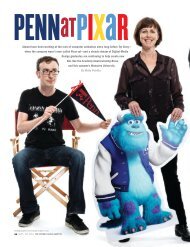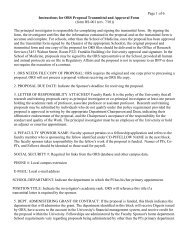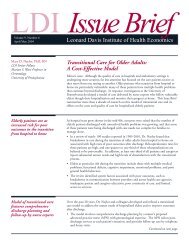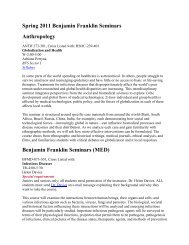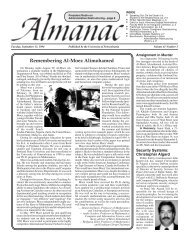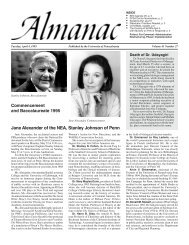Download this article (PDF) - University of Pennsylvania
Download this article (PDF) - University of Pennsylvania
Download this article (PDF) - University of Pennsylvania
Create successful ePaper yourself
Turn your PDF publications into a flip-book with our unique Google optimized e-Paper software.
“It was a two-way street—actually, a three- or four- or fiveway<br />
street,” says Nancy Steinhardt, pr<strong>of</strong>essor <strong>of</strong> East Asian<br />
art and curator <strong>of</strong> Chinese art at the Penn Museum.<br />
“Religion, ideas, and specific art forms and motifs traveled<br />
across central Asia from the key production centers <strong>of</strong> art:<br />
China, India, and Iran.” While one can probably see “more<br />
<strong>of</strong> China in Xinjiang than <strong>of</strong> places west <strong>of</strong> China in China,”<br />
there are also “hybrids, blends, mixtures, and juxtapositions,”<br />
she adds. “The confrontation and sometimes merging<br />
<strong>of</strong> cultures is, in my opinion, what makes the Silk Road<br />
sites so interesting.”<br />
Despite the romantic images associated with its name,<br />
the Silk Road was never a real road, just a series <strong>of</strong><br />
shifting trade routes connecting the area that is<br />
now Xinjiang to the rest <strong>of</strong> Eurasia. And it was only<br />
in the 1870s that Ferdinand von Richth<strong>of</strong>en, a German geologist<br />
and the Red Baron’s uncle, coined the moniker.<br />
Though those routes spanned some 4,000 miles, and linked<br />
East with West, the eastern portion didn’t begin to open up<br />
until 108 BCE, when the Chinese Emperor Wu began pushing<br />
the rival Xiongnu empire westward into central Asia. (Fun<br />
fact: Several hundred years later, a branch <strong>of</strong> the Xiongnu<br />
would reinvent itself as the Huns.) Both <strong>of</strong> the real mummies<br />
in the Secrets <strong>of</strong> the Silk Road exhibition—the Beauty <strong>of</strong><br />
Xiaohe (1800-1500 BCE) and the Infant Mummy (8th century<br />
BCE)—thus predate the opening <strong>of</strong> what we call the Silk Road<br />
by quite a few centuries. But the Silk Road wasn’t the only<br />
point <strong>of</strong> cultural interface. As Steinhardt points out, “whenever<br />
anyone travels across Asia, in peace or for war, there is<br />
the possibility <strong>of</strong> cultural interaction and exchange.”<br />
The Silk Road had pretty much died out by the 15th century<br />
CE, victim <strong>of</strong> improved maritime routes and the decline <strong>of</strong> the<br />
Mongol Empire, among other things. By then the Tocharians<br />
were long gone, at least as a recognizable people.<br />
“By about the 10th century, the Tocharians had almost<br />
disappeared from the stage <strong>of</strong> history,” Mair said during a<br />
1998 Nova episode filmed in Xinjiang. “I suspect that what<br />
happened to them is that they were primarily absorbed by<br />
the Turkic peoples who were moving into <strong>this</strong> area and<br />
replacing them. I believe that the legacy <strong>of</strong> the earliest<br />
inhabitants <strong>of</strong> the Tarim Basin survive in the current modern<br />
populations.<br />
“They now believe that they are Uyghurs, or Tajiks, or<br />
some other group,” he added. “But in my estimation, these<br />
are just carrying on the old Tocharian influence.”<br />
Having studied the Tocharians for so long that he’s become<br />
a “bit <strong>of</strong> a Tocharian” himself, Mair has no doubt that he<br />
could “channel” them—and that they would be glad to know<br />
there’s so much scholarly interest in them these days.<br />
“I think they’d be very proud,” he says, and as the late-afternoon<br />
light illuminates his gray beard he looks rather proud<br />
himself. “I think they’d say, ‘We’ve been rescued from obscurity.<br />
People had forgotten about us for a thousand years, and<br />
we could have been forgotten forever. Now these people, in a<br />
very far-away place, care so much about us, and are figuring<br />
out things about our past that even we didn’t know, and<br />
they’re bringing us back to life. And we’re very grateful.’”◆<br />
Ancient<br />
Secrets<br />
Found and shared<br />
A blockbuster exhibition,<br />
Secrets <strong>of</strong> the Silk Road,<br />
is coming to the<br />
Penn Museum.<br />
Human beauty is evanescent.<br />
Yet when you gaze on the<br />
flaxen-haired Beauty <strong>of</strong><br />
Xiaohe—even in a photograph—<br />
the usual metrics crumble.<br />
She’s 3,800 years old, after all.<br />
Chinese archaeologists unearthed the sleeping Beauty in<br />
2003, and when they opened her c<strong>of</strong>fin, “her hat was slanted<br />
like <strong>this</strong>,” says Victor Mair, pr<strong>of</strong>essor <strong>of</strong> Chinese language<br />
and literature, angling his hand across his brow. “I always<br />
refer to her as very alluring—almost seductive. She has such<br />
beautiful features—just lovely. Her lips are great; her teeth<br />
are great. She is gorgeous!”<br />
That Mair is so cheerfully besotted with a woman whose<br />
age can be measured in millennia isn’t only because he’s<br />
an archaeologist, though that’s certainly a big part <strong>of</strong> it.<br />
(See main story.) Her beauty gives new meaning to the<br />
word timeless, and the artifacts buried with her suggest<br />
that a similar reverence attended her death.<br />
“All in all, <strong>this</strong> is a sumptuous burial <strong>of</strong> a stunningly<br />
beautiful woman who was much loved by those who interred<br />
her,” notes the Secrets <strong>of</strong> the Silk Road catalogue, which<br />
cites such other “striking attributes” as “the wooden phallus<br />
on her chest, the magnificent felt hat, the fine fur-lined<br />
leather boots, and the string skirt.”<br />
The Beauty <strong>of</strong> Xiaohe is just one <strong>of</strong> the more eye-dazzling<br />
sights in the Secrets <strong>of</strong> the Silk Road exhibition, which<br />
opens February 5 at the Penn Museum and runs until June<br />
44 JAN | FEB 2011 THE PENNSYLVANIA GAZETTE



